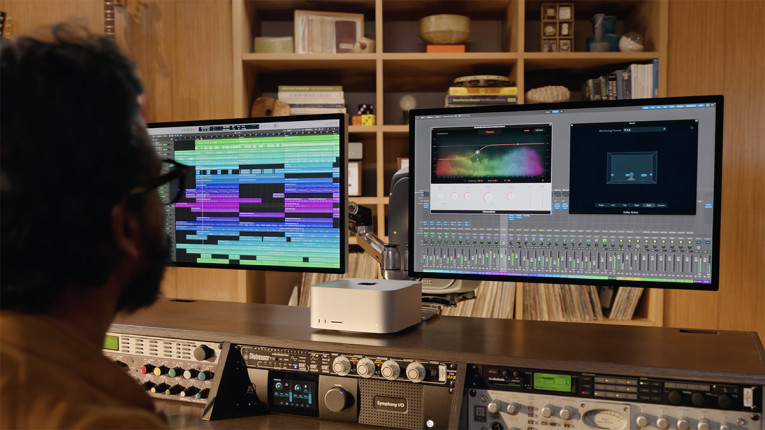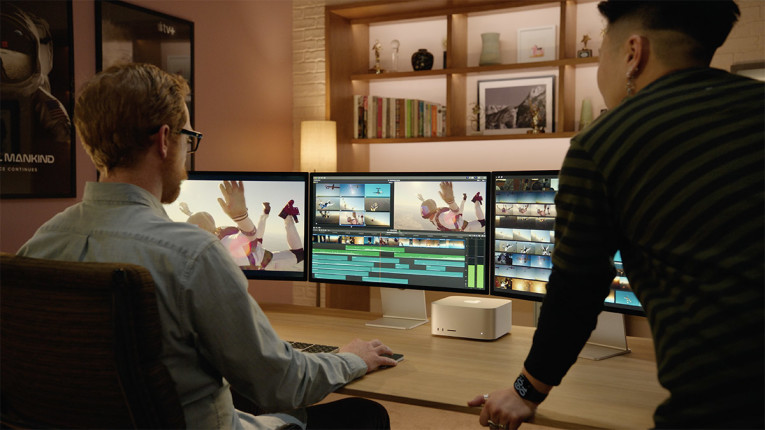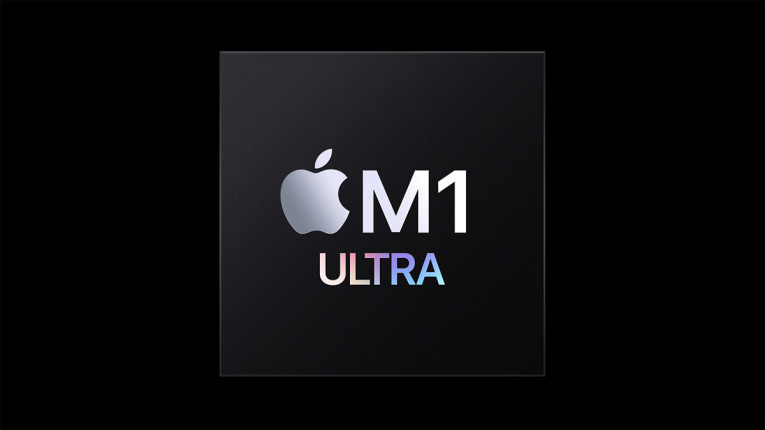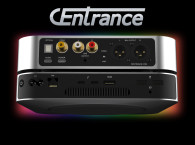
Apple is close to conclude its transition to Apple Silicon in its Mac computers, now missing only the ultimate performer that is the Mac Pro. For now, we learned that the 2022 lineup will no longer include a 27" iMac (the last one being the 2019 Intel i9 based machine - that audioXpress uses daily) or even an iMac Pro (which was basically lacking a sufficiently performing Intel processor, which until today never materialized). Without having to be restricted to the iMac form factor, Apple opted to create a completely new compact design for the Mac Studio, creating a modular platform that starts at 3.5x the performance of a top spec'ed iMac Intel i9 with the best available GPU and 64GB of memory - and goes from there to levels that currently don't exist in personal computers and workstations.
As Apple explains, the new Mac Studio and Studio Display were designed thinking about music studios, post-production suites, modeling, simulation and mechanical design studios, and the highest computing requirements - such as rendering massive 3D environments and playing back 18 streams of 8K ProRes video. This is an entirely new Mac desktop and display designed to give users everything they need to build the studio of their dreams, powered by the M1 Max chip that powers the MacBook Pro, as well as a completely new chip, the M1 Ultra, now the world’s most powerful chip for a personal computer.
With the power and efficiency of Apple silicon, the new Mac chassis was designed to optimize the performance of M1 Max and M1 Ultra, producing an unprecedented amount of power and capability in a form factor that can live right on a desk. Built from a single aluminum extrusion with a square footprint of just 7.7 inches and a height of only 3.7 inches, the Mac Studio takes up very little space and fits perfectly under most displays, and because of the efficiency of Apple silicon, Mac Studio remains incredibly quiet, even under the heaviest workloads.

For users requiring all the computing power they can get, the M1 Ultra is the next giant leap for Apple silicon, building on the M1 Max and featuring an all-new UltraFusion architecture that effectively interconnects the die of two M1 Max chips, creating a system on a chip (SoC) with unprecedented levels of performance and capabilities, and consisting of 114 billion transistors - the most ever in a personal computer chip.
With its ultra-powerful media engine, Mac Studio shatters the limits of graphics memory on a desktop, featuring up to 64GB of unified memory on systems with M1 Max and up to 128GB of unified memory on systems with M1 Ultra - incredible for music studios working with hundreds of tracks, sampling engines, synthesizers, and processing plug-ins, all at the same time. Since the most powerful workstation graphics card available today only offers 48GB of video memory, having this massive amount of memory is game changing for professional workloads. And the SSD in Mac Studio delivers up to 7.4GB/s of performance and a capacity of up to 8TB, allowing users to work on massive projects with incredible speed and performance.

On the back, Mac Studio includes four Thunderbolt 4 ports to connect displays and high-performance devices, a 10Gb Ethernet port, two USB-A ports, an HDMI port, and a pro audio jack for high-impedance headphones or external amplified speakers. Wi-Fi 6 and Bluetooth 5.0 are built in as well.
And because users frequently connect and disconnect devices, like portable storage, Mac Studio includes ports on the front for more convenient access. There are two USB-C ports, which on M1 Max supports 10Gb/s USB 3, and on M1 Ultra supports 40Gb/s Thunderbolt 4. There is also an SD card slot on the front to easily import photos and video. And Mac Studio provides extensive display support — up to four Pro Display XDRs, plus a 4K TV — driving nearly 90 million pixels.
The Mac Studio also offers an extensive array of USB-C and Thunderbolt 4 connectivity, sitting within arm’s reach on the desk and staying close to the new Studio Display. The display has three USB-C ports that deliver speeds up to 10Gb/s to connect high-speed peripherals, storage, and networking. A Thunderbolt port enables users to connect Studio Display and any connected peripherals to their Mac with a single cable. The same cable also delivers 96W of power to a Mac notebook, allowing to even fast-charge a 14-inch MacBook Pro. And up to three Studio Displays can be connected to a MacBook Pro, creating a powerful studio bay or workspace.
This new 27" 5K Retina screen features a built-in 12MP Ultra Wide front camera with Center Stage (a feature that automatically keeps users centered in the frame as they move around for even more engaging video calls), and a high-fidelity six-speaker sound system with spatial audio rendering of Dolby Atmos sources, using four force-cancelling woofers and two high-performance tweeters. Featuring the A13 Bionic chip, Studio Display also includes a studio-quality, three-microphone array with an especially low noise floor for crystal-clear calls and voice recordings.

To complement the design of Studio Display, there’s a new silver-and-black color option for Magic Keyboard with Touch ID, Magic Trackpad, and Magic Mouse, available to purchase separately.
Important to note, since Apple is leading efficiency and sustainability efforts in the consumer space, the new Mac Studio and Studio Display use far less energy and are built with 100 percent recycled rare earth elements in all magnets and recycled tin in the solder of the main logic board — as well as recycled aluminum and plastic in various components. Today, Apple is already carbon neutral for its global corporate operations, and by 2030, plans to have net-zero climate impact across the entire business, which includes manufacturing supply chains and all product life cycles.
The new Mac Studio and Studio Display are available to order now, with shipping beginning Friday, March 18. Mac Studio starts at $1,999 (US), and $1,799 (US) for education. Studio Display is $1,599 (US), and $1,499 (US) for education. Additional configuration options available now show that a decent M1 Max basic configuration of Mac Studio and a single Studio Display, cost the same as it would the iMac 27" 3 years ago - at around $2,799 USD - with twice the RAM (64GB). A "boosted to the max" Mac Studio M1 Ultra with 128GB low-latency memory and 8TB of SSD storage tops at $7,999, which is much less than the Mac Pro, for a performance level that doesn't exist today.

Apple Silicon Ultra
This ultimate M1 Ultra system can be configured with up to a 20-core CPU, 64-core GPU, and 32-core Neural Engine, providing astonishing performance for developers compiling code, artists working in huge 3D environments that were previously impossible to render, and video professionals who can transcode video to ProRes up to 5.6x faster than with a 28-core Mac Pro with Afterburner. With a 64-core GPU, the M1 Ultra chip delivers faster performance than even the highest-end PC GPU available today, while using 200 fewer watts of power.
For those working in artificial intelligence and machine learning engines, the 32-core Neural Engine in M1 Ultra runs up to 22 trillion operations per second, speeding through the most challenging tasks. The M1 Ultra also integrates custom Apple technologies, such as a display engine capable of driving multiple external displays, integrated Thunderbolt 4 controllers, and best-in-class security, including Apple’s latest Secure Enclave, hardware-verified secure boot, and runtime anti-exploitation technologies.
"M1 Ultra is another game-changer for Apple silicon that once again will shock the PC industry. By connecting two M1 Max die with our UltraFusion packaging architecture, we’re able to scale Apple silicon to unprecedented new heights," says Johny Srouji, Apple’s senior vice president of Hardware Technologies. "With its powerful CPU, massive GPU, incredible Neural Engine, ProRes hardware acceleration, and huge amount of unified memory, M1 Ultra completes the M1 family as the world’s most powerful and capable chip for a personal computer."
www.apple.com









